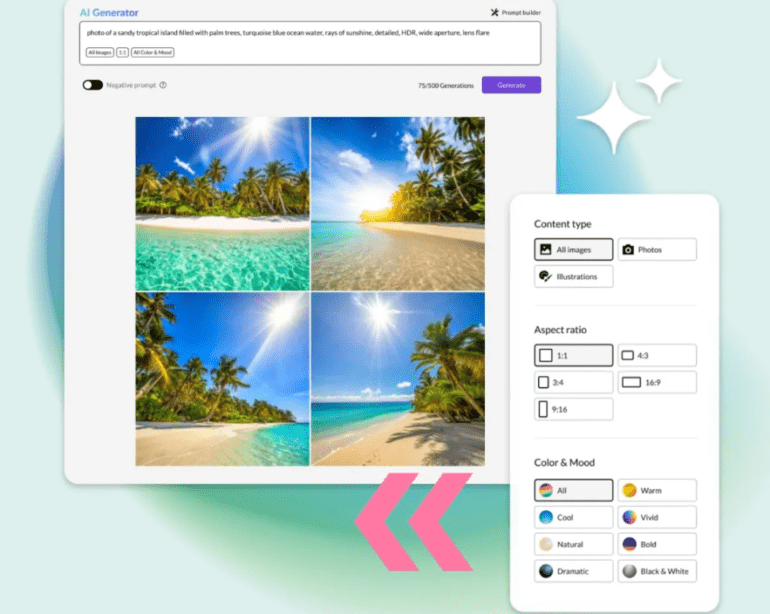TL;DR:
- Getty Images introduces Generative AI, a powerful tool for creating visuals from text descriptions.
- The tool, powered by Nvidia’s AI model, taps into Getty’s vast content library of 477 million assets.
- Customers receive a standard royalty-free license with indemnification for copyright protection.
- Safeguards are in place to prevent misuse, disinformation, or imitation of living artists’ styles.
- Generated images are watermarked as AI-created.
- Contributors used to train the AI model will be compensated, and revenues will be shared.
- Customization options and pricing separate from standard subscriptions will be available.
- The move is part of Getty’s responsible AI development strategy.
Main AI News:
Getty Images has unveiled its latest innovation: Generative AI by Getty Images. This groundbreaking tool, developed in collaboration with Nvidia, leverages the immense wealth of Getty’s content library, comprising approximately 477 million assets, to produce visuals from textual descriptions or prompts. In a bid to assure customers of its reliability for commercial use, Getty Images offers its standard royalty-free license, complete with indemnification against potential copyright claims and the right to “perpetual, worldwide, nonexclusive” utilization across all media platforms.
This cutting-edge technology, however, is not without its safeguards. Getty has meticulously implemented measures to prevent the misuse of its generative tool for disinformation, misinformation, or the imitation of living artists’ styles. For instance, it restricts the creation of images featuring public figures like Joe Biden in specific contexts, such as in front of the White House, or emulating the distinctive style of artists like Andy Warhol. Moreover, all images generated by the tool are adorned with a watermark, clearly designating them as AI-generated creations.
Craig Peters, CEO at Getty Images, articulated the company’s commitment to responsible AI development for commercial purposes, stating, “We’ve worked hard to develop a responsible tool that gives customers confidence in visuals produced by generative AI for commercial purposes.”
Getty Images has clarified that the content generated by its tool will not be incorporated into its content library for licensing by others but reserves the right to retrain its model using these images. Contributors whose works are used to train the underlying model will receive compensation, and Getty has pledged to share the revenues generated by the tool. This sharing will be based on a formula accounting for various factors, ensuring equitable compensation for contributors.
The tool’s accessibility extends to Getty’s website and integration into applications and websites through an API. In the near future, customers will even have the capability to customize the tool using proprietary data, enabling the creation of images that align with a specific brand style or design language. Pricing will be distinct from standard Getty Images subscriptions, based on prompt volume.
Grant Farhall, Chief Product Officer at Getty, expressed the vision behind this innovative offering, stating, “We’ve created a service that allows brands and marketers to safely embrace AI and stretch their creative possibilities, while compensating creators for inclusion of their visuals in the underlying training sets.”
This development follows Getty Images’ public stance against generative AI products like Stable Diffusion, which had been trained on a subset of its image content library. Getty took legal action against AI startup Stability AI, alleging unauthorized use of millions of images and associated metadata owned by Getty without due compensation or notification to contributors. Craig Peters likened this legal battle to the early days of digital music, highlighting the importance of addressing intellectual property rights in the generative AI landscape.
While some AI companies argue that their content-scraping practices are protected under the fair use doctrine, the legal intricacies surrounding this issue remain unresolved.
Getty Images is not alone in exploring more ethical and responsible approaches to generative AI in the commercial realm. AI startup Bria, for instance, offers a generative AI art tool trained on licensed content from various partners, providing revenue sharing to creators. Another noteworthy example is Ascendant Art, an avatar creator that commits to paying royalties to artists who contribute their work to train its models. Even established players like Shutterstock and Adobe are stepping up, offering compensation models to reward contributors for their contributions to generative AI technology.
Conclusion:
Getty Images’ launch of Generative AI signifies a significant advancement in the creative content generation market. This innovative tool, backed by Nvidia’s AI capabilities, offers businesses and marketers a safer and more versatile means of embracing AI for creative purposes while ensuring responsible use. The move also reflects Getty’s commitment to addressing intellectual property rights in the generative AI landscape, setting a precedent for ethical and commercially viable AI-driven content creation.

